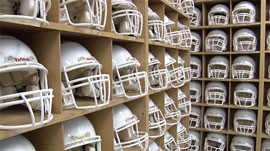- Slug: Sports-Concussions-Innovations
- Photo below
- Video on YouTube
- Note: Part of “Concussions” package (all related stories slugged “Sports-Concussions-XXX)
By NICK SHAW
Cronkite News
Accelerometers. Mouthpieces that turn blue. IV dye. PET scores. Phone apps.
In the escalating battle against concussions, doctors are developing more and more tools to combat head injuries.
Primarily focusing on education, Dr. Javier Cardenas has seen a number of innovations in new equipment, but he has some reservations.
“There’s a lot of devices and tools that are upcoming,” said Cardenas, the medical director of the Barrow Neurological Institute and one of the nation’s leading neurologists. “The problem is the cart is before the horse with most of them. It really is important to do the research first before marketing devices and objects to families.”
While accelerometers may not be the best tool in determining if someone has sustained a concussion, Cardenas said the future is discovering when an athlete has suffered a brain injury and when they have completely recovered to return safely to play.
The Translational Genomics Research Institute, along with Arizona State University and A.T. Still University, has targeted just that.
“(We are) looking for biomarkers, specifically micro-RNA biomarkers in the blood, urine and saliva of those who are injured but also those who have sustained the greatest number of hits and the greatest frequency of hits,” said Cardenas.
Dr. Roger McCoy, head athletic trainer at Arizona State, sees it as a part of the future of concussion detection.
“Instead of all of these tests on the sidelines and in the locker room, our hope would be something like a mouthpiece that would turn blue,” McCoy said. “When that protein is secreted and now you know that person is concussed, there is no question about it.”
McCoy also alluded to research in other states and facilities that may prove useful in the effort to protect athletes.
“In New Mexico and (along) the East Coast, they are combining an IV dye and a PET scan,” McCoy said. “Concussions do not show up on an MRI or a CT scan. So with a PET scan and dye they can see the physiology of the brain. Right now we rely on our exams and our neurological testing to do that.”
When it comes to local high school and youth sports, the Barrow Concussion Network is closely working with the community. The Arizona Interscholastic Association has partnered with Barrow to provide concussion education and baseline testing to student-athletes.
Dr. Tamara McLeod, director of the athletic training program at A.T. Still University, has worked with AIA since 2009 and alongside Barrow since 2011. Together, A.T. Still and Barrow created simple tests that can be performed using your phone.
“Specific to the baseline testing, we have helped (high schools) to develop and test their athletes on measures of symptoms, balance and cognitive function,” McLeod said. “Through that, we use various computerized neurocognitive test platforms, some of them as simple as an app you can download onto your iPhone.”
Strides have been made over the years to develop equipment and protocols regarding concussions, but there have been some drawbacks in trying to implement rules and gear, especially around the state.
“AIA looks out for all student-athletes across the state and there are health care disparities when you look at the availability of athletic trainers at a high school,” McLeod said. “What might be going on in Mesa could be very different than in Safford. So they’re really trying to help to identify means that all of those athletes can have access to the same resources that those in the metro Phoenix area have.”
Cost is another issue preventing high school and younger athletes from receiving the best care. The allocation of resources plays a large role. The Barrow Concussion Network is hoping new equipment and medical testing currently being researched is available for everyone.
“If it’s a blood test, a saliva test, with technology hopefully there will be an affordable way of getting it down to that level or supplying it as a district,” McCoy said. “Each individual team may not need it, but at every game the devise is there.”
Cardenas and the network are hoping to change a culture and the approach teams and leagues take to tackle “hidden injuries.” McCoy said he thinks new equipment and testing will start to appear in the near future.
“Many of our tests are relying on the athlete being honest about their symptoms and how they feel. I think you’ll start to see some (equipment) as early as three to five years, especially the PET scans and advanced imaging that measure the tissue and physiological function of the brain. It takes a lot of guesswork out of it.”

ASU Head Athletic Trainer Dr. Rodger McCoy is working with the Barrow Neurological Institute to develop new equipment that will detect and monitor head injuries. “No helmet, no head device ever can protect you from a concussion completely,” Dr. McCoy said.
(Cronkite News photo by Ben Margiott)